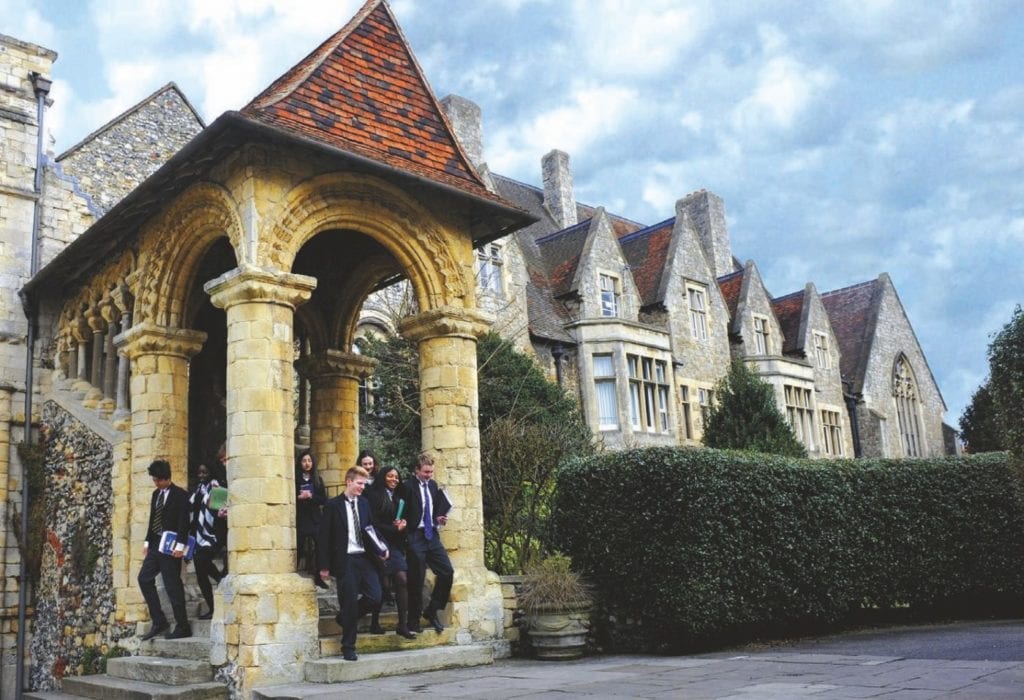The King’s School
We take a look at the long and illustrious history of The King’s School in Canterbury; one of the oldest schools in the world.
With origins dating back to 597AD, The King’s School, Canterbury is reputedly the oldest school in the world. It is also one of the country’s leading coeducational day and boarding schools located in the idyllic surroundings of the Precincts of Canterbury Cathedral (a UNESCO World Heritage Site), just one hour from Central London.
The School buildings are steeped in history with interesting and quirky tales from their past which make the School a truly unique place to live and learn.
The main entrance to the School, The Mint Yard Gate, was built in 1864 following the demolition of the old almonry building and leads into The Mint Yard, a mixed quadrangle of classrooms and boarding houses named after a short-lived sixteenth century royal mint.
The Grange, a former boys’ boarding house was built on the granary ruins as a family house in the 1840s. It incorporates architectural features from the old Archbishop’s Palace. Above the main entrance are the arms of Cardinal Pole which acknowledge that he gave the Mint Yard to the School.
The Norman Staircase is one of the most painted, photographed and admired sites in Canterbury. As its name suggests it dates back to the 12th century. For formal occasions the School traditionally gathered here. Archbishops of Canterbury addressed the School from the Staircase during Visitations and King George VI, accompanied by Queen Elizabeth and Princess Elizabeth, presented the School’s Royal Charter to the Dean on 11 July 1946.
The Dark Entry forms the link between the Green Court and the rest of the Precincts and the Cathedral. It was built in the late 14th century. The Dark Entry is supposed to be haunted by the ghost of Nell Cook. R.H. Barham in The Ingoldsby Legends recounts ‘A King’s Scholar’s Story’ about a Canon in ‘bluff King Harry’s days’ and his cook. Nell is buried alive and haunts the Dark Entry.
Linacre House is now a boys’ boarding house. It is a fine Georgian building, incorporating part of the medieval prior’s lodging. Horatio Nelson’s brother William was a Canon here from 1803 to 1835, and Lady Hamilton visited him. It was later used by the Royal School of Church Music.
Meister Omers, popularly known as MO, is a boys’ boarding house. It was built in the fifteenth century by Cardinal Beaufort and has one of the widest fireplaces in England. Edward IV held a Parliament here in 1470. Cardinal Coligny is said to have died here in suspicious circumstances in 1568, and the arms of Queen Elizabeth, originally in an upstairs dormitory but now in the hall, probably mark her visit in 1573.
Abbot Fyndon’s Great Gate, the entrance to St. Augustine’s, forms part of the remains of the first Benedictine Abbey in England, established around AD598 following the arrival of Augustine of Canterbury, a Benedictine monk who became the first Archbishop of Canterbury.
It was rebuilt from 1301-1309 by Abbot Fyndon. In 1625 Charles I and Henrietta Maria stayed in the State Chambers over the gateway arch on their wedding night, following their marriage in Canterbury Cathedral. Elizabeth I is also reputed to have been welcomed to the State Chambers. After the abbey was dissolved by Henry VIII the abbey buildings were converted to a number of other uses. The gatehouse served for some time as a brewery under the ownership of Messrs. Bennett and Beer, who produced St Augustine’s beer (naturally!).
The school has Open Mornings each term for prospective pupils and their families. To register your interest please visit – https://www.kings-school.co.uk/admissions/open-mornings/
Posted in: Features



